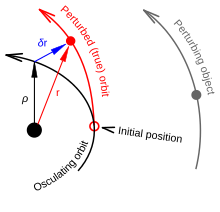
In astronomy, and in particular in astrodynamics, the osculating orbit of an object in space at a given moment in time is the gravitational Kepler orbit (i.e. an elliptic or other conic one) that it would have around its central body if perturbations were absent.[1] That is, it is the orbit that coincides with the current orbital state vectors (position and velocity).
- ^ Moulton, Forest R. (1970) [1902]. Introduction to Celestial Mechanics (2nd revised ed.). Mineola, New York: Dover. pp. 322–23. ISBN 0486646874.